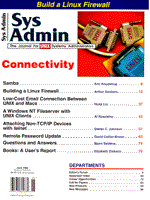
Sidebar: TCP/IP Addresses
One of the most commonly used IP network addresses today is 192.1.0.0. Why? Because it, or a similar address, is often used in configuration examples found in many hardware and software manuals. These configurations are often implemented "as is" with no modification either because the site administrator is unfamiliar with IP address registration, or because it is assumed that the configured systems will never be attached to the worldwide Internet. It is interesting to note that the address mentioned above, as well as others like 192.x.0.0 and 192.0.x.0 are valid addresses on the Internet. You may have noticed that the addresses 192.168.65.0 and 192.168.81.0 are used in this article. These addresses were not just pulled out of thin air. They, as well as quite a few others, have been reserved by the Internet Assigned Numbers Authority (IANA) for use by any organization on its internal networks. RFC1597 documents the reservation of the following addresses:
10.0.0.0 - 10.255.255.255 172.16.0.0 - 172.31.0.0 192.168.0.0 - 192.168.255.255
As RFC1597 notes "the first block is nothing but a single class A network number, while the second block is a set of 16 contiguous class B network numbers, and the third block is a set of 255 contiguous class C network numbers." The RFC continues: "An enterprise that decides to use IP addresses out of the address space defined in this document [RFC1597] can do so without any coordination with IANA or an Internet registry. Addresses with this private address space will only be unique within the enterprise." Organizations that decide to use these addresses on their internal segments have the flexibility to implement arbitrarily large networks without having to worry about readdressing everything if/when Internet attachment is implemented. Additionally, a measure of network security is ensured by using these addresses, because hosts so addressed are inaccessible from direct communication with the worldwide Internet. (RFC1597 is available via ftp from rs.internic.net as well as a number of other sites.)
|